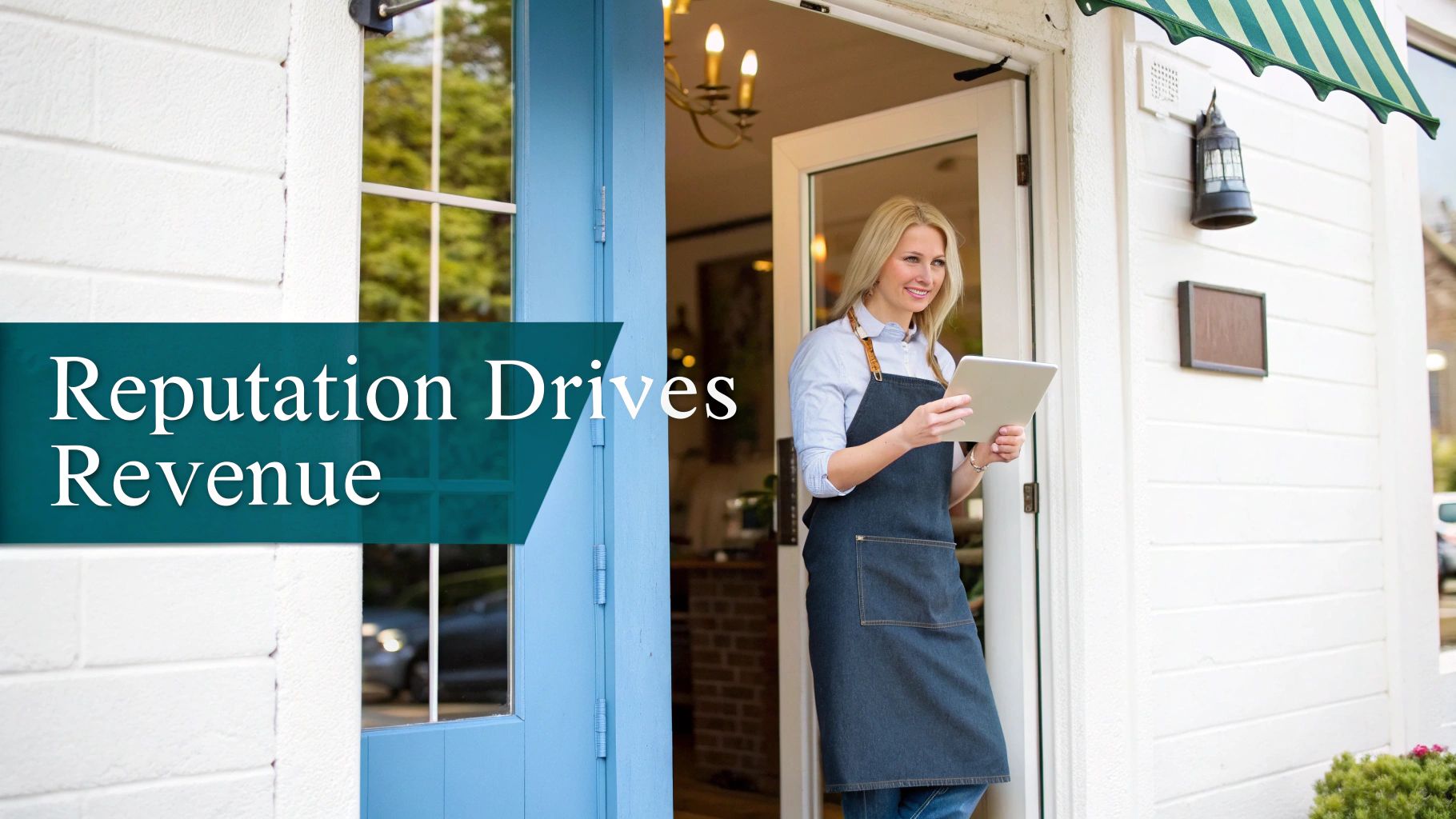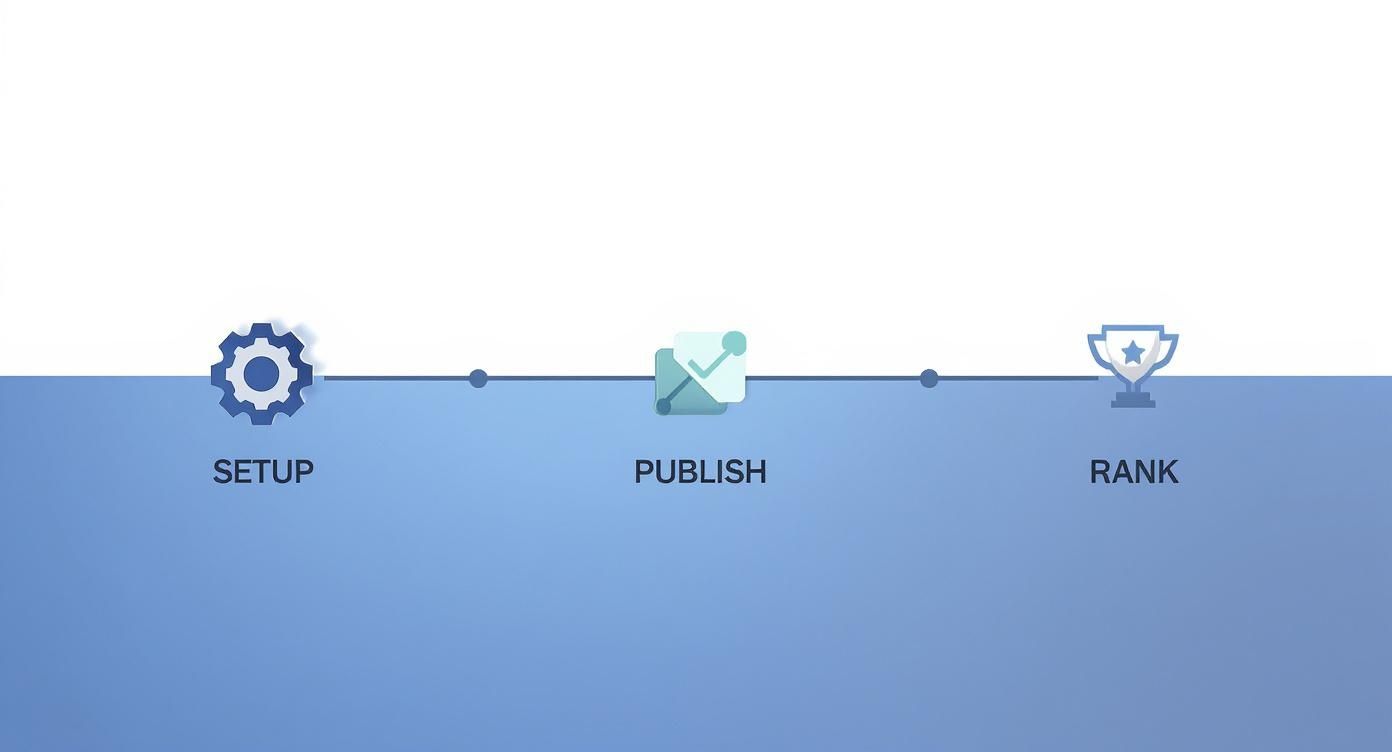
Let's cut the fluff. As a founder, you're not managing a reputation; you're managing a revenue stream. The line between a 4-star and a 5-star rating isn't about ego—it's about whether you're paying the bills this month or scaling your team. Forget corporate PR speak. This is a practical, founder-to-founder guide on how we actually manage our reputation at BillyBuzz, without the expensive tools or wasted time.
Your Reputation Is Your Revenue

Your online reputation isn't a marketing task for a spare moment. At BillyBuzz, we treat it like a core KPI, right alongside lead conversion and CAC. Every review, comment, and mention is a data point that predicts future sales.
Think about it. When you're choosing a new SaaS tool, you go straight to the reviews on G2 or Capterra. That's your customer's exact behavior. Right now, someone is weighing you against a competitor, and their decision will be made in the reviews section.
The Financial Impact of Customer Perception
The link between perception and profit is direct. We've seen firsthand how focusing on reputation impacts the bottom line. The data backs it up: businesses with over 50 online reviews can earn up to 4.6 times more revenue.
Even better, just responding to reviews can lead to a 35% increase in revenue. On Google and Yelp, every extra star can boost revenue by 5% to 9%.
This requires a founder's mindset shift. Your reputation isn't something that happens to you; it's an asset you build. Ignore it, and you're leaving cash on the table.
"We stopped seeing reviews as simple feedback and started treating them as measurable indicators of future revenue. This one change transformed our approach to customer service and growth."
Start with the quick wins—the low-effort tasks that deliver the biggest ROI.
The ROI of Reputation Management Quick Wins
| Tactic | Potential Revenue Impact | Effort Level |
|---|---|---|
| Respond to all new reviews within 24 hours | Increases customer trust and can boost revenue by up to 35% | Low |
| Claim and optimize your Google Business Profile | Improves local search visibility, directly driving leads | Low |
| Actively solicit reviews from happy customers | Each additional star can increase revenue by 5-9% | Medium |
| Address a recurring negative feedback point | Prevents future negative reviews and improves retention | Medium |
Starting here is the fastest way to see a tangible return. Nail these basics, then move on to the full strategy.
Turning Sentiment into a Growth Engine
A proactive strategy turns customer chatter into your best growth tool. This is about spotting opportunities, not just putting out fires.
- Positive Reviews as Social Proof: Glowing testimonials are your best marketing material. They build instant trust.
- Negative Feedback as R&D: Handled well, negative reviews are free consulting. They show you exactly what to fix in your product or service.
- Engagement as a Loyalty Loop: Responding to all feedback shows customers you're listening. It strengthens relationships and drives retention.
Once you grasp this connection, everything changes. For a deeper dive, it's worth reading up on how reputation management drives revenue for small businesses. The underlying principle is the same one we apply to all marketing channels, which you can see in our guide on https://www.billybuzz.com/blog/measuring-social-media-roi-cost-benefit-analysis. Every action should have a clear, positive, and measurable impact on your business.
Our No-Fluff Brand Monitoring System
Forget expensive monitoring stacks. As a founder, your time is your most valuable asset. Here’s the exact, scrappy system we use at BillyBuzz to catch every important mention without drowning in noise. It’s built on free tools and smart filters. Solid small business online reputation management starts with knowing what people are saying, the moment they say it.
The Foundation: Google Alerts
First up: Google Alerts. It’s free, simple, and the bedrock of our system. Don't just set an alert for your brand name. Cast a wider net.
Here are the exact alert rules we set up for BillyBuzz. This multi-alert approach catches direct mentions, misspellings, and indirect conversations.
"BillyBuzz"(with quotes for exact match)"Billy Buzz"(for common misspellings)"Founder's Name"(monitor your personal brand)"BillyBuzz" AND "Reddit"(to track specific platform mentions)"competitor name" AND "alternative"(to find switchers)
Set the frequency to "As-it-happens" and the source to "Automatic" to get a comprehensive view from news, blogs, and the web.
Targeted Social Listening on Reddit
Google Alerts misses the raw, unfiltered conversations in communities like Reddit. Since our ideal customers live there, we have to go deeper. Instead of monitoring all of Reddit (a firehose of noise), we zero in on subreddits where our customers hang out.
We don't just track our brand name. We listen for buying signals with these exact keyword filters:
- Problem-Aware Keywords:
track reddit mentions,find customers on reddit,social listening tool - Competitor Mentions:
brand24 alternative,mentionlytics vs - Solution-Seeking Questions:
best tool for reddit monitoring,how to monitor subreddits
We only monitor these terms within a curated list of communities: r/smallbusiness, r/SaaS, r/marketing, r/Entrepreneur, and r/startup. This surgical approach brings high-intent conversations directly to us. For a full walkthrough, check our guide on setting up real-time social media alerts.
As a founder, your job isn't to listen to every conversation—it's to be present in the right conversations. Filtering by community and intent is how you manage your reputation without wasting hours.
This targeted strategy is also a crucial part of understanding your place in the market. To truly have a no-fluff system, you need to accurately track and analyze share of voice measurement to see how you stack up against the competition.
Our Quick-Reference Response Templates
When you find a mention, speed matters. We keep these templates in a shared Notion doc so anyone on our team can respond quickly and consistently.
Template 1: Mention with a Question"Hey [Username], great question. Our tool actually solves this by [briefly explain feature]. Happy to share more if you're interested!"
Template 2: Unsolicited Positive Mention"Thanks for the shout-out, [Username]! So glad to hear you're finding [Product Name] helpful. We really appreciate it!"
Template 3: Mention with a Complaint"Hi [Username], sorry to hear you're running into trouble. That's definitely not the experience we want for our users. Could you send us a DM with your account email so we can investigate this for you right away?"
These three templates cover 80% of mentions. They provide a solid starting point that we can personalize in seconds, allowing us to respond in minutes, not hours.
How We Respond to Every Type of Review

Every review is a public conversation, not just with the reviewer, but with every prospect who reads it. Most founders overlook this. At BillyBuzz, we have a playbook for turning every star rating into a strategic advantage. This isn't PR speak; it's a human framework for effective small business online reputation management.
The stakes are high. 93% of consumers read online reviews before buying, and 92% avoid a business with less than a 4-star rating. A prompt response shows you're accountable. Dive deeper into the data on the full power of online reviews here.
The 5-Star Review Playbook: Turning Customers into Advocates
A 5-star review is great, but a simple "Thank you!" is a wasted opportunity. Our goal is to amplify that positivity and turn a happy customer into a vocal advocate.
Our 5-Star Response Recipe:
- Acknowledge a specific detail: "Thanks so much, [Customer Name]! We're thrilled you found the AI relevancy scoring so helpful for filtering out the noise."
- Reinforce their positive outcome: "Saving you hours of manual work is exactly what we aim for, so it's fantastic to hear it's making a real difference."
- Encourage future engagement: "We have some new features coming soon that we think you'll love. Thanks again for being a part of the BillyBuzz community!"
This validates their experience, reminds other readers of our key value, and makes them feel part of our journey.
Neutralizing the 3-Star Review
A 3-star review is the trickiest. The customer isn't angry, but they're not happy either. This is our chance to show we're listening and committed to improving. Our goal is to find the friction point and prove our responsiveness.
"A 3-star review is an invitation for a conversation. The reviewer didn't hate your product; they just felt it fell short of its promise in some way. Your response can either win them back or push them away for good."
Our 3-Star Response Recipe:
- Thank them for the honest feedback: "Hi [Customer Name], thanks for taking the time to share your thoughts. We really appreciate the honest feedback."
- Acknowledge their specific issue: "We understand your point about the initial setup being a bit complex. That's valuable insight for our product team."
- Offer a solution or next step: "We're actually working on a new onboarding flow to address this. In the meantime, our support team would be happy to walk you through a few shortcuts. Please feel free to reach out."
We don't get defensive. We listen, validate, and provide a path forward, turning a lukewarm experience into a positive one.
The 1-Star Review De-Escalation Framework
A 1-star review feels like a punch to the gut. An emotional response only makes it worse. We stick to a simple three-step framework: Acknowledge, Apologize, Act. This isn't about admitting fault; it's about owning their negative experience.
Our 'Acknowledge, Apologize, Act' Framework:
- Acknowledge: "Hi [Customer Name]. Thank you for bringing this to our attention. We've read your feedback about the issue with Slack notifications."
- Apologize: "We're very sorry to hear that this has been a frustrating experience for you. That is absolutely not the level of service we aim to provide."
- Act: "I've asked our head of support to investigate this immediately. Could you please email us at [support@billybuzz.com] with your account details so we can resolve this for you personally and take this conversation offline?"
This de-escalates tension, shows you're taking action, and moves the heated details out of the public eye. For everyone else reading, it proves you fix problems.
How to Proactively Build a 5-Star Reputation

A great reputation isn't built by accident. If you just wait for good reviews, you'll end up with a mediocre rating. The only way to get a steady stream of authentic, positive feedback is to ask for it. This is the cornerstone of any effective small business online reputation management strategy.
Identifying the Perfect Moment to Ask
Timing is everything. Ask at the wrong time and it feels awkward. Catch customers in their "happy moments"—when they’re feeling the most satisfaction from your product. For us, this means looking for key success signals.
We reach out at these golden opportunities:
- Right after a great support interaction: When we've quickly solved a problem, they're often incredibly grateful.
- When a customer upgrades their plan: A clear vote of confidence.
- After they hit a key milestone: For our users, this might be their 10th engaged lead or their first month of consistent monitoring.
Link the review request to a positive emotion they're already feeling. It becomes a natural next step, not a chore.
Crafting the Perfect, Non-Pushy Ask
How you ask is just as critical as when. Be direct, appreciative, and simple. Short, personalized messages work best.
Your goal isn't to pressure every customer into leaving a review. It's to make it incredibly easy for your happiest customers to share their experience. The easier you make it, the more reviews you'll get.
Here are two templates we use that convert well.
Email Template for a Post-Success Follow-Up"Hey [Customer Name],
So glad to see you're getting great results with [Feature Name]! Happy customers like you are the reason we do what we do.
If you have a spare minute, would you be willing to share your experience on [Review Platform]? It would mean a lot to our team and help other founders discover us.
Here's the direct link: [Link to Review Site]
Thanks for being a part of our community,[Your Name]"
In-App / SMS Template for Brevity"Loving BillyBuzz? Share your feedback in 30 seconds and help other small businesses find us! [Link]"
Notice the low-pressure language like "if you have a spare minute" and the direct link to remove all friction.
Turning Feedback into Your Best Marketing Content
Your work isn't done when a five-star review comes in. A glowing testimonial is powerful social proof. We have a simple process to amplify every great piece of feedback.
- Website Testimonials: We feature the best quotes on our homepage and pricing pages to build immediate trust.
- Social Media Content: A simple graphic with a customer quote makes for fantastic content on LinkedIn and X.
- Sales Collateral: We sprinkle reviews into sales decks and case studies to add credibility.
This ensures a single piece of positive feedback provides ongoing value, building a fortress of social proof around our brand.
Using SEO to Take Control of Your Brand's Story
When someone Googles your business, that first page of results is your digital storefront. Are you writing that story, or is a random angry customer? This is Search Engine Reputation Management (SERM). The goal is simple: when a prospect looks you up, they see the positive, professional image you want them to. For any founder, this is a non-negotiable part of small business online reputation management.
Build Your Digital Fortress with Properties You Own
Your first line of defense is owning as much of that first-page real estate as possible. Search engines favor official profiles. If you optimize these, they'll outrank a random negative post.
Lock down these core assets first:
- Google Business Profile (GBP): Your most powerful tool. Keep it meticulously updated with posts, photos, and active Q&A responses. Google rewards this activity.
- LinkedIn Company Page: A complete, polished page almost always ranks high. Fill it out completely.
- Key Industry Directories: Profiles on sites like Clutch, G2, or Yelp carry weight. Claim and fully optimize every relevant profile.
Create Content That Pushes You to the Top
Once your profiles are solid, go on the offensive. A steady stream of positive, helpful content populates search results with links you control. Our content strategy is built around proving our expertise and solving real problems.
Your profiles are your defense. Your content is your offense. While optimized profiles protect your reputation, high-quality content actively pushes your positive story forward, making it incredibly difficult for negative stuff to get any traction.
We focus on content that ranks well for branded searches:
- In-depth Blog Posts: Articles that solve a genuine problem for our target audience.
- Customer Case Studies: Real-world success stories build trust.
- Founder Interviews & Guest Posts: Getting your name on other reputable sites is a huge authority builder.
- Press Mentions: Even a small mention in an industry publication can rank surprisingly well.
This ties directly into our broader SEO work. By creating valuable content, we naturally attract backlinks, which tells search engines we're credible. We dive deeper into this in our guide on social signals and link building.
The Simple Math of Pushing Down Negative Results
SERM is a game of displacement. Google's first page has about ten spots. Your job is to fill as many as possible with positive content you own or influence.
Imagine a single negative article pops up. If you already control your website (#1), GBP (#2), LinkedIn page (#3), and a recent guest post (#4), that negative result is already pushed halfway down. Add a few more positive assets, and you can push it right off the first page where almost no one will see it.
Preparing for a Reputation Crisis Before It Hits
A reputation crisis isn't a possibility; it's an inevitability. It's not if, but when. One viral post, a product recall, or a simple misunderstanding can undo years of work overnight. Waiting for the fire to start before looking for the extinguisher is a rookie mistake. A plan lets you respond with calm authority, not panicked chaos. It's an essential insurance policy for your brand.
Assemble Your Crisis Response Team
When things go sideways, you need a designated response team now, while things are calm. At BillyBuzz, our team is our CEO, head of marketing, and lead customer support agent.
Our roles are simple and clear:
- The Decider: Our CEO has the final say on the official response. This prevents internal debate when time is critical.
- The Communicator: Our marketing lead drafts all messages and manages social channels.
- The Investigator: The support lead gathers facts from customer interactions to ensure our response is accurate.
Everyone else funnels information to this small group. This prevents mixed messages from making a bad situation worse.
A crisis creates confusion. Your first job is to establish a single source of truth for all communication, both internal and external. This simple step prevents the chaos from multiplying.
Draft Holding Statements Now
You can't predict the exact crisis, but you can anticipate the types of problems: service outages, negative press, a data issue. We keep a shared document with pre-drafted "holding statements" for these scenarios. This buys you time while you gather facts.
Our holding statement for a service outage:
"We are aware of an issue currently affecting [Service Name]. Our team is investigating the cause and working on a solution. We sincerely apologize for the disruption and will provide another update within [Timeframe, e.g., 30 minutes]."
It acknowledges the problem, shows you’re taking action, and sets clear expectations.
This infographic lays out the typical timeline for getting a handle on your search engine reputation, from the initial groundwork all the way to seeing positive results climb the rankings.

As you can see, the critical piece in the middle is consistently publishing your own content. It’s what connects all your initial optimization efforts to long-term success on search engines.
Monitor Sentiment in Real-Time
During a crisis, your standard monitoring won't cut it. We switch gears and create a temporary, crisis-specific alert in our tool. We track our brand name alongside negative keywords like "outage," "scam," "broken," or "warning." This gives us a real-time feed of the evolving narrative, allowing us to adapt on the fly.
The small business online reputation management market is projected to hit USD 12.57 billion by 2030 for a reason. With regulators cracking down on fake reviews, founders are investing in authentic reputation management. You can get a deeper dive into the trends shaping the ORM market to see where things are headed.
Frequently Asked Questions
As a founder, you need straight answers, not academic theories. Here are the most common questions we get from other small business owners, answered with a no-fluff approach.
How Much Time Should I Spend on This Each Week?
Once your system is set up, you're looking at 1-2 hours a week. My advice: block out 15-20 minutes every morning to scan alerts and reply to new reviews. The initial setup—Google Alerts, social listening filters, response templates—will take a few hours upfront. After that, maintenance is minimal. Consistency beats volume. A little attention each day is far better than a frantic scramble once a month.
What Is the Best Way to Handle a Fake Negative Review?
First, don't engage emotionally. Your immediate goal is to report the review for removal, citing a clear violation of the platform's terms of service (spam, hate speech, conflict of interest).
"A calm, professional response to a fake review isn't for the person who wrote it; it's for every future customer who reads it. You're showing them you're reasonable and responsive, even when someone is being dishonest."
While you wait, post a single, calm, public reply.
Here’s our template:
"We take all customer feedback seriously. After checking our records thoroughly, we can't find any customer or transaction that matches the details in this review. We would encourage the reviewer to contact our support team directly with more information so we can look into this further."
This shows you're diligent without getting into a mud-slinging match.
Is It Worth Paying for Reputation Management Software?
For most small businesses starting out, no. The free tools we've covered—like Google Alerts and basic social listening—are more than enough.
You should only consider paid software when the volume of mentions becomes too much to handle manually. The tipping point is when the time you spend managing your reputation costs more than the software's monthly fee. A restaurant with three locations getting dozens of reviews a day? A paid tool is a lifesaver. A B2B consultant getting a few mentions a month? The free approach is perfect.
Ready to stop guessing and start finding high-intent customers on Reddit? BillyBuzz uses AI to monitor the communities that matter, filtering out the noise and alerting you to conversations where your business can shine. Start your free trial today and turn Reddit into your most powerful lead-generation engine.
